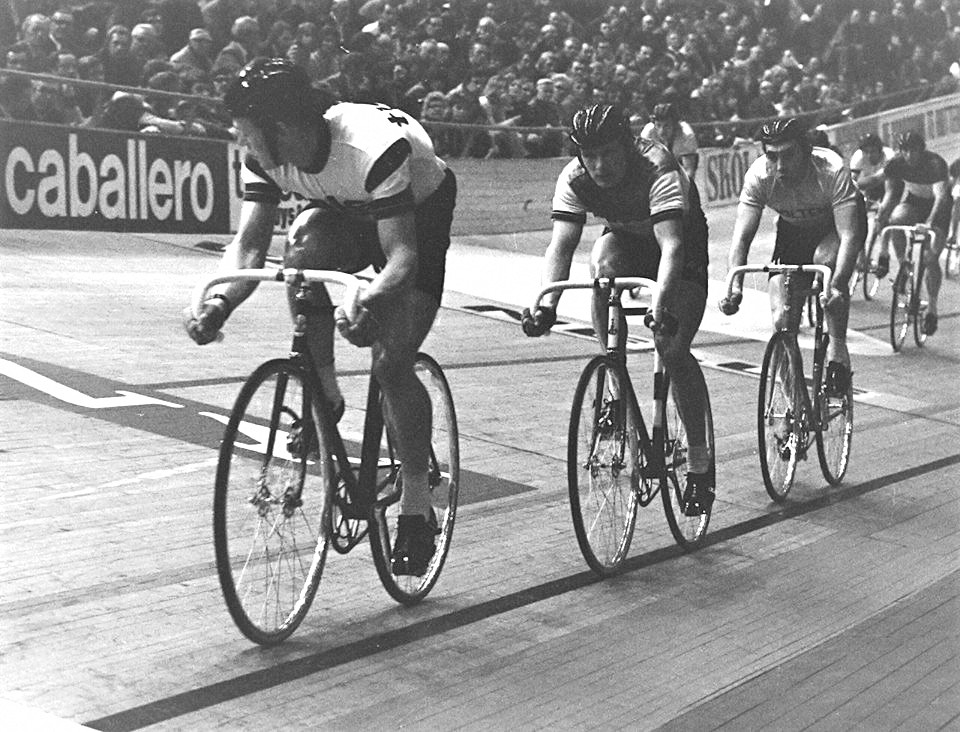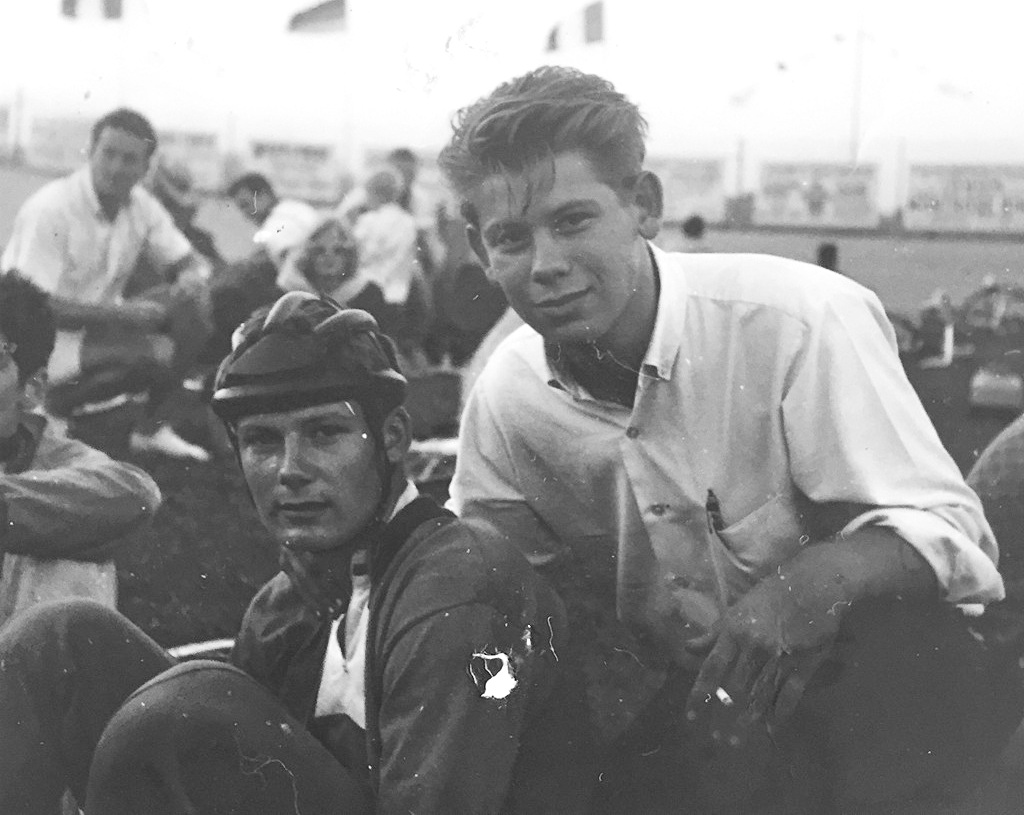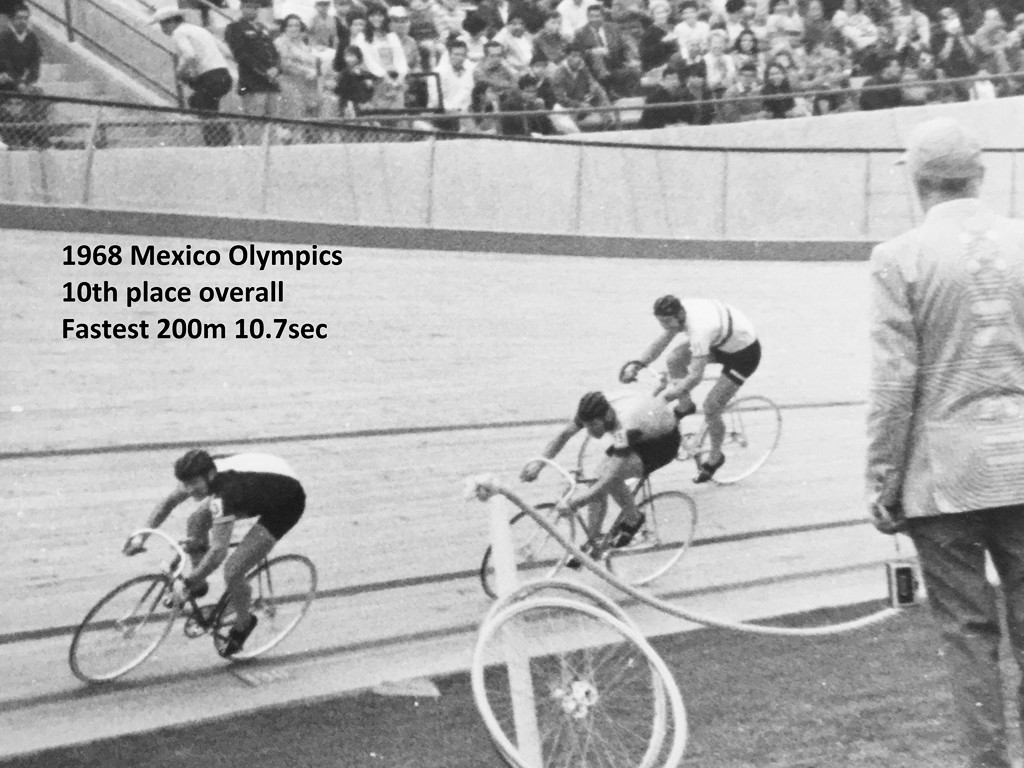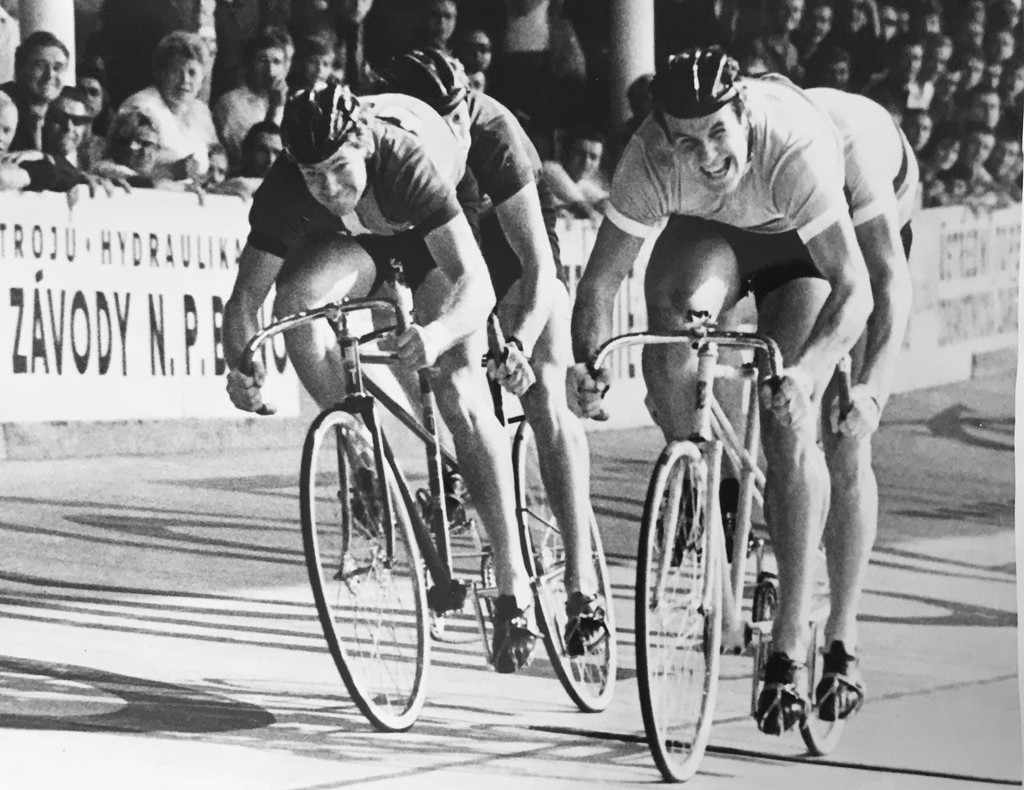Tim Mountford was one of the pioneers of US professional cycling in the 60’s and 70’s; he recently gave freely of his time to tell VeloVeritas about his adventures in what was a golden age for European cycling.
It’s a ‘biggie’ so we’ll be running it over four parts.
In 1970 many Europeans wondered what inspired the talented athlete Tim Mountford from Surf City, California to hop on a one-way plane to Paris to pursue a challenging career in European professional Six Day racing, when in fact he had never seen a Six Day race in his life.
Earlier at fifteen years old Tim had plenty of street smarts and self-confidence as well as a silent contempt for anyone in his way.

At eighteen years-old while in his final year of high school Tim was living on his own, sharing a flat with another rider, worked at a local bike shop, was training for the 1964 Olympic Games in Tokyo and was creator and chief editor of a cycling magazine titled the Southern California Cycling Journal.
“I have no idea where my energy came from other than I saw life as a race and I wasn’t going to lose, not after seeing my mother suffer financially because of others! Early on I viewed my amateur racing career as a possible stepping stone to professional racing in Europe.”
Looking back Tim reflects,
“Based on sheer determination my brother and I worked our way up in life; he becoming a millionaire by selling life insurance and I capitalised on my cycling career owning three bike shops and later as a corporate executive in Silicon Valley.
“Six Day racing gave me the strength and guts to forge a new path during difficult times.”
In the 60’s bike racing wasn’t popular in America; how did you get into cycling, what inspired you?
“In 1962 all the stars were aligned for me to enter bicycle racing and that included the only European style 250 metre banked velodrome in America located in my city.
“There was also a local cycling club that included former Olympic cyclist and speed skaters who raced. And I had the support of my older brother who recognized my athletic ability.
“I would go on to compete in two Olympic Games (10th in Mexico City), the World Championships (4th), a Pan American Games bronze medal, and eventually a European professional racing career that included four pro teams, several European championship rides in four different disciplines and acceptance into both the European Pro Six Day circuit and Dutch criteriums.
“It was a fun and exciting twelve-year journey I will never forget including the wonderful people I met along the way.
“My interest in cycling first started at fifteen years old with two of my friends. Just a couple of kids looking for something exciting to do in sunny southern California.
“We fitted our English three speed bikes with dropped racing handlebars so we could better climb the three miles up the famous Laurel Canyon mountain pass for the sole purpose to zoom down the other side at great speed into Hollywood.
“We often rode our bikes next to movie stars in their cars who lived in the canyon which was also an area where musicians like the Mamas and Papas, Crosby Stills & Nash and Joan Baez started their careers and wrote their music.
“Racing down the canyon was like a Disneyland thrill ride on two wheels, and it was free every weekend.
“The trip back home required an hour ride around the bottom of the mountain that included a tour of Hollywood boulevard littered with hundreds of tourists from around the world.
“One hot day while riding up the canyon with my two friends an emotional feeling of excitement overcame me as we approached our usual rest stop half way up the canyon… I said to myself “I’m going to beat these guys to the top. I’m not stopping!”
“From that day forward we began to race each other up Laurel Canyon and I won every time.
“At the time my older brother, Stan had started work at the local bike shop in North Hollywood. Stan saw my interest in cycling and he acquired a basic model second hand Swiss Allegro road bike for me that December. Perhaps he also felt I needed a distraction as I was becoming mischievous and hanging out with some rough dudes and getting into fights.
“For Christmas Stan gave me a complete Sergal Italian cycling kit including Ditto Pietro shoes with Anquetil cleats. That morning we went on a 40-mile ride and, at three years my senior, he wasn’t too pleased that I kept dropping him off my wheel.
“A few weeks later my life changed forever when Stan put me on his recently acquired track bike so I could try riding the new Encino Velodrome. I had never seen a velodrome before that day, but riding the banked turns was like flying a jet airplane and I instantly knew that track racing was what I wanted to do.
“The following week I cut my long Elvis Presley style hair, stopped smoking cigarettes, and dropped all my looser friends.
“I often tell this story explaining that I am a living example of how cycling can inspire and change the life direction of young teenagers.”

The ’64, Olympics, you rode the tandem – memories of that event?
“Yes, the ’64 Tokyo Olympics was my introduction to international racing at 18 years old. As I mentioned, our cycling club, The North Hollywood Wheelmen, had a few Olympians.
“I was paired on the tandem with our famous sprinter Jack Disney (not the Disneyland guy) who competed in the ’56 Olympics, was a five-time national sprint champion, and performed well in many international competitions. He was also a world class speed skater like his brother who won a silver medal in the 1960 Squaw Valley winter Olympics 500m race. So, for weight training and sprinting, I had a good coach and training partner from the beginning.
“In Tokyo on the Olympic velodrome we were informed by the Russian coach that he clocked us in training at 10.3 for 200m on the bumpy 400m cement track… one of the fastest times on that track.
“Jack and I made it through the first couple of eliminations rounds of the tandem sprint competition. Our eighth-finals series was the only three up match that included us and the Dutch and English tandems.
“We lead out down the back stretch on the bell lap, however, we were not going fast enough in turn three and by turn four the Dutch team (van de Touw and de Graaf, two big boys who finished in fourth place) got on top of us and started bumping against us going through turn four, and we lost.
“In other cycling events Patrick Sercu won the kilo, and Walter Godefroot won a bronze in the road race while Eddy Merckx was delayed by a crash in the final turn.
“I had no idea that six years later I would be racing as a pro against these guys.”
The ’68, Olympics and the sprint – recollections?
“Following the Tokyo Olympics I won several California state championships, two silver and a bronze medal in the national championships and a bronze in the 1967 Pan American Games in Winnipeg, Canada.
“In preparation for the ’68 Olympic Games in Mexico I spent the previous winter in the gym lifting weights with some insane body builder dudes and their magic potions; I gained ten pounds of muscle and could do three sets of incline sit-ups while holding a 25lb plate behind my head, and do jump squats with 250lbs.
“I was ready to bump shoulders with the Europeans in my next Olympic sprint competition.
“I had a wonderful time in Mexico City and was satisfied with my results. I did well in the elimination rounds finishing in tenth place losing to Omar Pkhakadze who finished in fourth place and gold medallist Daniel Morelon.
“I did beat a few favourites including current and future world champs Niels Fredborg of Denmark, Gordon Johnson of Australia, and Peder Pederson of Denmark posting a 200 meter time of 10.7 in the process.
“In hindsight, at the altitude of Mexico City and racing on the fast 333m hard wood track I wish I had used a 49 or 50 x 14 gear. In those days it was all about leg speed and everyone used a 48 x 14 gear which Morelon confirmed with me years later. Perhaps I started my sprints too early as I simply ran out of gear in the final fifty meters before the finish line.
“I left Mexico inspired to pursue more international competition.”

1969 US Sprint Champion after several podiums, that must have been satisfying?
“After the Mexico Olympics I concluded that I had to make money in bicycle racing or get a good paying job. It took only a minute and I decided that I would move to Europe after the 1969 amateur world championships in Czechoslovakia.
“This meant that the 1969 U.S. Amateur National Championships in August would be my last attempt at a gold medal.
“Once again in the finals I was up against my good friend Jackie Simes. The previous year Jackie had won a silver medal in the World Championships in Kilo TT as well as a few Pan American Games medals by then.
“I was ready this time and I beat him two straight adding a national championship gold medal to my collection.
“Two days later Jackie and I were on a plane to Czechoslovakia to race in the world championships.”
You were ’69 fourth in the Tandem Worlds – any ‘what ifs’ on that one?
“Yes, I had one big ‘what if’ after the semi-finals of the tandem event in Brno, Czechoslovakia against the East Germans who eventually won the gold.
“We should have taken them from the front in the second ride. We were faster!
“In the individual sprint competition Jackie and I performed well but were eliminated before the quarter finals. I did a 1:09 kilo TT (again!), and the next race was the tandem sprints.
“The first time Jackie and I rode the tandem together was the day before the championships. We did one practice sprint and said to each other; ‘wow, we can go fast together.’
“We won the first two rounds, the eighth and quarter finals, then met the East German team of Geschke and Otto in the semi-finals. Our plan was to come from behind in the final turn and take advantage of the large wind draft created by the German machine. The plan went well as we forced their speed going into the bell lap on the 400 meter track.
“We jumped at them in turn one, but within thirty meters we immediately closed the four bike lengths distance up to their rear wheel. We now knew that they were holding back and wanted to force us to slow our speed or force us over the top going into turn three where they could then run us high on the track.
“We didn’t fall for the trick and we kept attacking the pedals while Jackie drifted our tandem high on the back stretch so we could recreate the distance we needed while at the same time increasing our speed.
“Going into turn three we knew that we had the speed and the timing to run their wind draft and pop past them to the finish line. We rode the same race plan in the second ride and both times we thought we had won. The results for both semi-final races were a photo finish given to the East Germans. Wow, we almost made it into the finals for gold.
“In the finals for 3rd and 4th against the French team, Olympic champions of Morelon-Trentin we had lost our edge and the French beat us by inches in both races.
“Fourth place was okay though for two Americans who previously never rode the tandem together.
“During the competition in Brno there were no races on the day of the first year anniversary of the Russian invasion of Czechoslovakia.
“That afternoon John Vande Velde (future father of Christian Vande Velde) and I were resting in our hotel room on the third floor when from our balcony we saw a stream of Russian tanks driving into the city centre of Brno to put down the protest. Minutes later the wind shifted and we could feel the sting of tear gas on our eyes.
“A few days later in the championships Audrey McElmury would be the first American to win the woman’s World Championship road race.
“After watching the men’s road race Jackie, John and I were on a plane to Trinidad for three days of grass track racing with many of the riders from the championships.”

Now jump to Part Two of Tim’s story.



